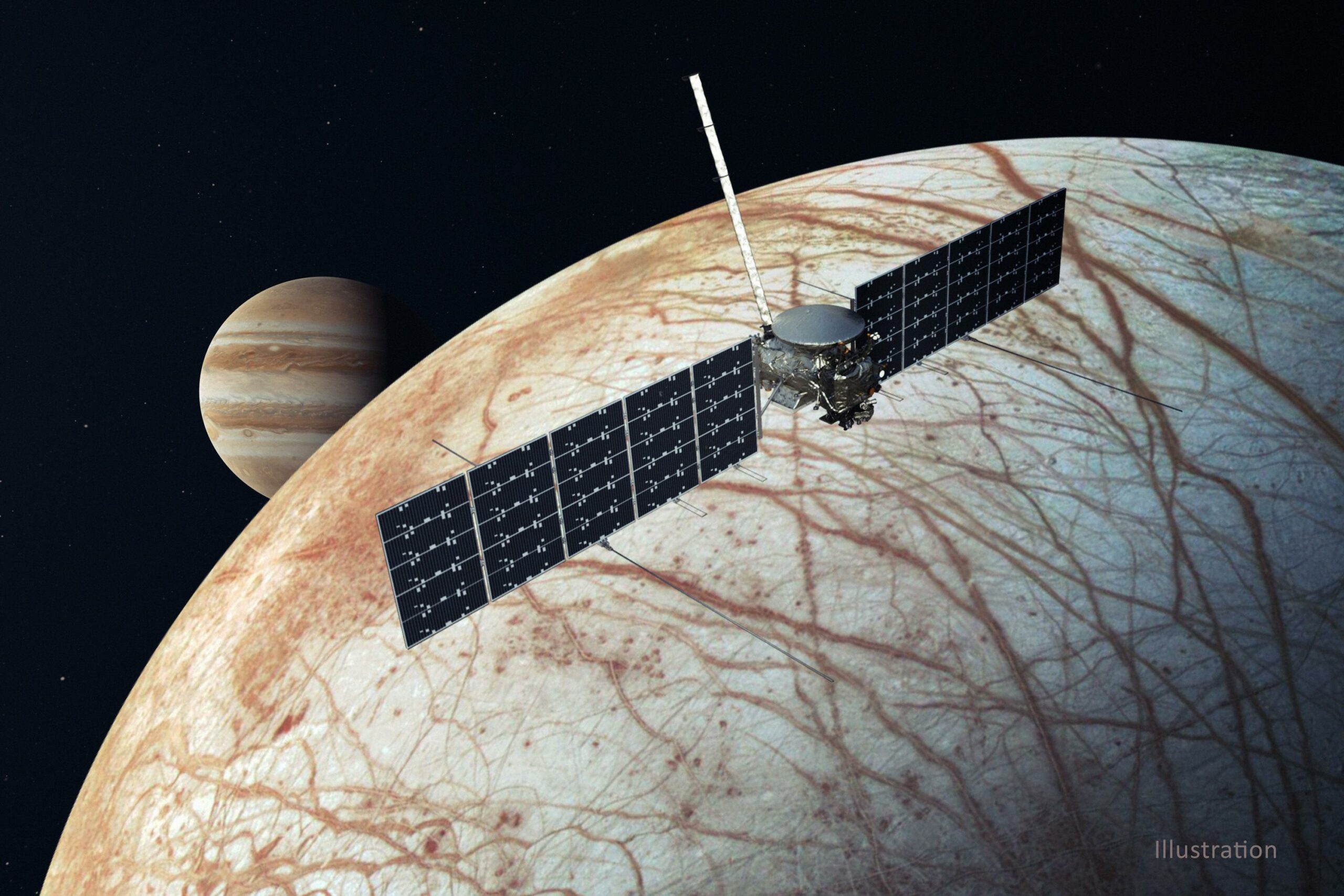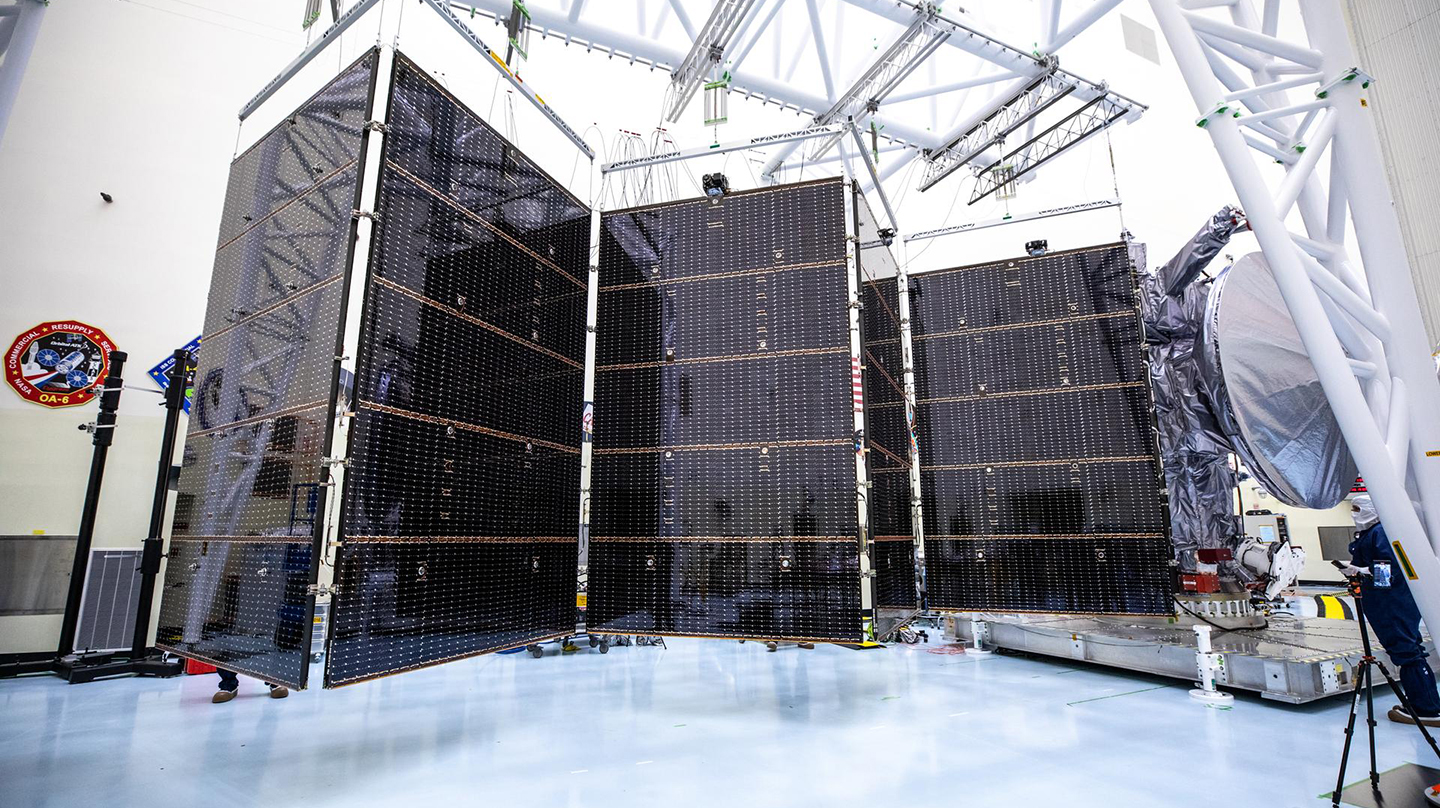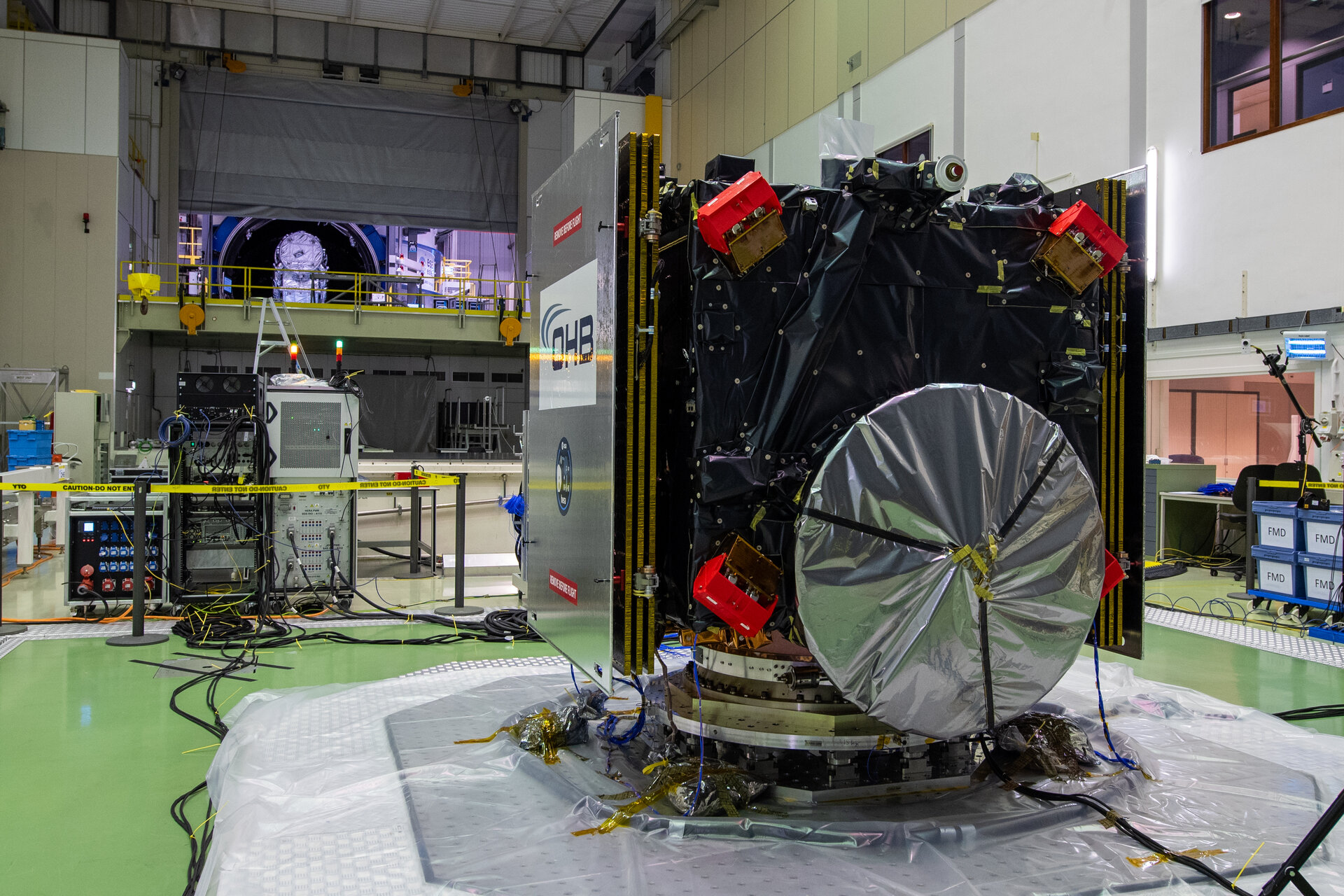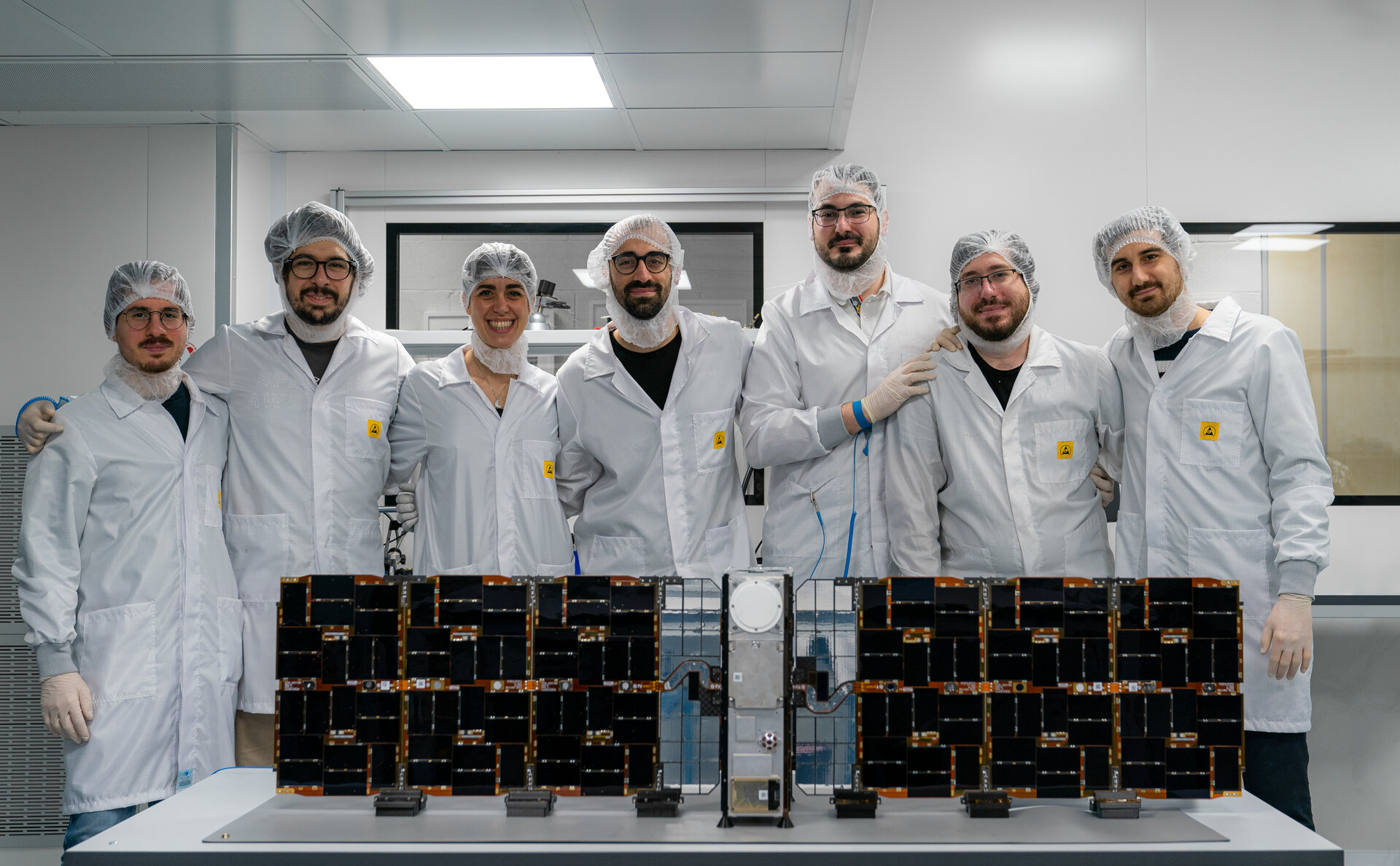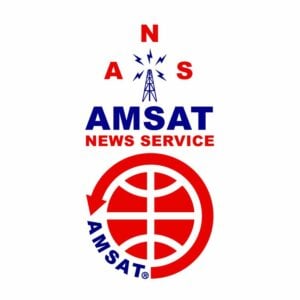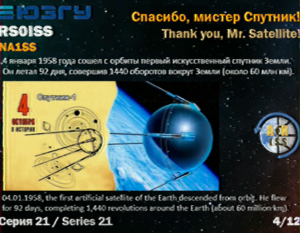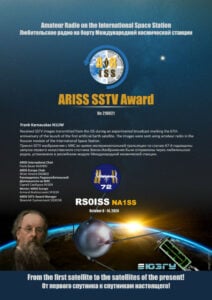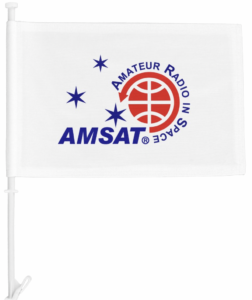In this edition:
- AMSAT AO-7 to Celebrate 50th Anniversary
- AMSAT 42nd Space Symposium Presentations Now Available
- Back to Basics: What is the CubeSat Launch Initiative?
- VUCC Satellite Standing for November 2024
- FO-29 November Operating Schedule
- Telemetry Reports Wanted for Upcoming ASRTU-1 Satellite Launch
- Voyager 1 Resorts to Transmitter that Hasn’t Been Used Since 1981
- Changes to AMSAT TLE Distribution for November 1, 2024
- ARISS News
- Upcoming Satellite Operations
- AMSAT Ambassador Activities
- Satellite Shorts From All Over
The AMSAT News Service bulletins are a free, weekly news and information service of AMSAT, the Radio Amateur Satellite Corporation. ANS publishes news related to Amateur Radio in Space including reports on the activities of a worldwide group of Amateur Radio operators who share an active interest in designing, building, launching and communicating through analog and digital Amateur Radio satellites.
The news feed on http://www.amsat.org publishes news of Amateur Radio in Space as soon as our volunteers can post it.
Please send any amateur satellite news or reports to: ans-editor [at] amsat [dot] org.
You can sign up for free e-mail delivery of the AMSAT News Service Bulletins via the ANS List; to join this list see: https://mailman.amsat.org/postorius/lists/ans.amsat.org/
ANS-308 AMSAT News Service Weekly Bulletins
To: All RADIO AMATEURS
From: Radio Amateur Satellite Corporation
712 H Street NE, Suite 1653
Washington, DC 20002
DATE 2024 Nov 03
AMSAT AO-7 to Celebrate 50th Anniversary
It has often been reported that the oldest satellites still working in space are the space probes Voyager 1 and Voyager 2. The Voyagers were both launched in 1977 to take advantage of the planetary alignment called, back then, the “Grand Tour”. Their images changed the human vision of our solar system.
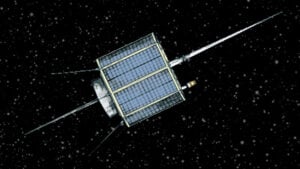
But, are they really the oldest, still functional spacecraft in outer space? What if we include spacecraft that remained behind in Earth Orbit? Is it even believable that the oldest still working satellite in space wasn’t even designed or operated by NASA, USAF, ESA or any other space agency? What if this satellite was designed by Radio Amateurs and the final assembly occurred in a basement laboratory not far from Goddard Space Flight Center?
Then all things considered, AO-7, a SmallSat launched on November 15, 1974 is the oldest working satellite and is still providing service to hundreds of Amateur Radio operators around the world. In its first life, AO-7 lived a very healthy lifetime of 6.5 years. Not to over-state the case, AO-7 outlived both its commercial and government co-passengers launched by Delta-104.
In late 1980, AO-7’s poor, abused, NiCad battery began to show serious signs of increased series resistance. This was a sure sign to AMSAT command stations that the end was in sight. The cells had been originally matched for capacity by NASA. And, indeed the cells all failed within a matter of weeks of one another.
AO-7 stayed asleep for 21 years, to the nearest month. Then one day AO-7 woke up again. This was only possible if something caused an open circuit in the battery.
A very active user of AO-7, Pat Gowain, G3IOR, from the UK, made a telephone call to Perry Klein, W3PK, (first AMSAT President and designer of the VHF/HF transponder). This was on June 21, 2002. Pat wondered if we had launched a new LEO spacecraft? He was hearing Morse Code Telemetry again on the old beacon frequency of AO-7. He played Perry a tape recording. It sure sounded like AO-7 telemetry!
Many radio amateurs who were satellite enthusiasts very quickly began to observe the signals from AO-7 and the second life of the “Sleeping Beauty” of satellites began.
Over the next three weeks in November AMSAT News Service will honor this historic achievement with a series of short articles highlighting the life of AMSAT OSCAR 7. In the meantime be sure to visit a special page on the AMSAT website where you will find a collection of AO-7 articles and links at https://www.amsat.org/amsat-ao-7-a-fifty-year-anniversary/.
[ANS thanks Jan King, W3GEY, AMSAT AO-7 Project Manager for the above information.]
The 2024 AMSAT President’s Club coins are here now!
Help Support GOLF and Fox Plus
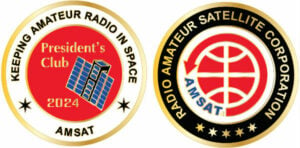
Join the AMSAT President’s Club today and help
Keep Amateur Radio in Space!
https://www.amsat.org/join-the-amsat-presidents-club/
AMSAT 42nd Space Symposium Presentations Now Available
The fifteen live presentations given at the recent AMSAT 42nd Space Symposium are now available online for viewing. The URL’s for presentations on Day 1 and Day 2 are shown along with the approximate timeline for each presentation.
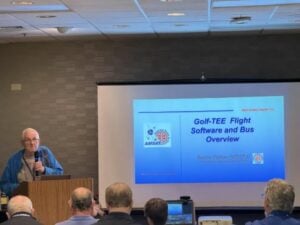
Also available is the Symposium Banquet keynote address by Brian Abbott, NA7D, and the AMSAT General Meeting conducted by AMSAT President Robert Bankston, KE4AL.
Day 1
https://www.youtube.com/watch?v=YdhYXX9AXlI
AMSAT-UK Payload on Jovian-1 CubeSat
David Bowman, G0MRF
0:00:58
CARD-SAT®: A Step Forward for Satellite Miniaturization
Adrian Totu, YO3HOT
0:58:15
Working QO-100 from Beyond the Nominal Footprint
Graham Shirville, G3VZV
1:18:55
AMSAT & ARISS Over the Past 40 Years
Frank Bauer, KA3HDO
2:01:20
MO-122 (MESAT1) Commissioning Recap
Mark Hammond, N8MH
2:35:05
AMSAT-HB Update
Michael Lipp, HB9WD
3:08:05
Fox Plus Update
Mike Moore, K4MVM
3:24:45
Day 2
https://www.youtube.com/watch?v=G64Zm7rEmi0
AMSAT CubeSatSim Education Update and Software Overview
Alan Johnston, KU2Y
0:00:48
Integration of the AMSAT CubeSat Simulator for Education and Research
Rachel Jones, KO4HLC
0:44:00
ARISS Engineering Update – ISS, Lunar, and Commercial Activities
Randy Berger, WA0D
1:47:00
Automation and Remote Control of the Inter-Operable Radio System (IORS) on the ISS
Chris Thompson, VE2TCP/G0KLA
2:51:56
Getting Ready to Receive HamTV from the ISS
Graham Shirville, G3VZV
3:36:00
GOLF-TEE Flight Software and Bus Overview
Burns Fisher, WB1FJ
4:22:55
Determination of Orbiting Spacecraft Space Vectors Solely from In-flight Position Measurements
Joseph DiVerdi, K0NMR
5:20:00
AMSAT Engineering Update
Jerry Buxton, N0JY
6:02:00
AMSAT Annual General Meeting & Awards Ceremony
Robert Bankston, KE4AK, AMSAT President
7:15:30
Banquet Keynote
https://www.youtube.com/watch?v=Gb-pQmr97KA
Brent Abbott, NA7D, Chief Revenue Officer , Rogue Space
0:00:45
[ANS thanks AMSAT for the above information.]
Back to Basics: What is the CubeSat Launch Initiative?
(Editor’s note: In this avocation, we sometimes toss around acronyms or titles with scant understanding of what they stand for. From time to time, ANS will offer short articles that can help up better understand the vocabulary of amateur satellites.)
The CubeSat Launch Initiative, or CSLI, is a NASA initiative that provides opportunities for qualified CubeSats to fly as auxiliary payloads on future launches that have excess capacity or as deployments from the International Space Station (ISS). In very simple terms that means that NASA will cover the cost of providing a CubeSat a ride to space in exchange for a report on the results of that CubeSat’s investigation.
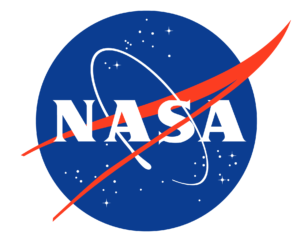
NASA’s CubeSat Launch Initiative provides opportunities for CubeSats built by U.S. educational institutions, and non-profit organizations, including informal educational institutions such as museums and science centers to fly on upcoming launches. Through innovative technology partnerships NASA provides these CubeSat developers a low cost pathway to conduct scientific investigations and technology demonstrations in space, thus enabling students, teachers, and faculty to obtain hands-on flight hardware design, development, and build experience.
CSLI provides a low-cost platform for NASA science missions, including planetary exploration, Earth observation, and fundamental Earth and space science. These efforts are a cornerstone in the development of cutting-edge NASA enabling technologies including laser communications, next generation avionics approaches, power generation, distributive sensor systems, satellite-to-satellite communications, and autonomous movement. Leveraging these missions for collaboration optimizes NASA’s technology investments, fosters open innovation, and facilitates technology infusion. CubeSat missions are enabling the acceleration of flight-qualified technology assistance in raising Technology Readiness Levels, which aligns to NASA’s objective of advancing the Nation’s capabilities by maturing cross-cutting innovative space technologies.
About half of all CSLI missions are conducting scientific investigations, most frequently Space Weather and Earth Science. Specific science investigation areas include: biological science, study of near Earth objects, climate change, snow/ice coverage, orbital debris, planetary science, space-based astronomy, and heliophysics. Sixty-six percent of all CSLI missions are conducting technology development or demonstrations. Communications, propulsion, navigation and control, and radiation testing lead the topics in this area. Other notable technologies are solar sails, additive manufacturing, femtosatellites, and smart phone satellites. The low cost of development for a CubeSat allows for conducting higher risk activities that would not be possible on large-scale NASA missions.
What is the difference between CSLI and ELaNa?
NASA’s Launch Services Program manifests CSLI payloads with a variety of launch providers. Each launch with manifested CSLI payloads is called an ELaNa mission (Educational Launch of Nanosatellites) and is given an ELaNa mission number (e.g., ELaNa 49, ELaNa 50). Simply put, CSLI is the payload and ELaNa is the ride.
To be eligible for CSLI, a CubeSat investigation must be of clear benefit to NASA by supporting at least one goal or objective stated in the NASA Strategic Plan. This plan can be found on NASA’s Web site http://www.nasa.gov.
[ANS thanks NASA for the above information.]
Need new satellite antennas?
Purchase M2 LEO-Packs from the AMSAT Store.
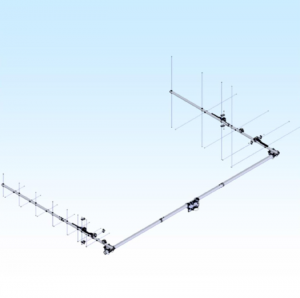
When you purchase through AMSAT, a portion of the proceeds goes towards
Keeping Amateur Radio in Space.
https://amsat.org/product-category/hardware/
VUCC Satellite Award/Endorsement Change Summary for October 1, 2024 to November 1, 2024.
DF2ET 1500 1602
KF7R 1154 1175
HB9AOF 743 907
W8LR 887 888
IK3ITB 604 800
N7ZO 650 669
N6UTC 600 651
F6GLJ 501 609
JA1GZK 500 575
HB9GWJ 514 553
DJ7NT 348 432
SP5ULN 156 404
JF3MKC 275 280
W6IA 246 278
WA3YDZ New 271
IC8TEM New 147
YB1RQX/P New 100
Congratulations to the new VUCC Satellite holders.
YB1RQX is first VUCC Satellite holder from OJ21
DXCC Satellite has still not been updated since May
[ANS thanks Jon Goering, N7AZ for the above information.]
FO-29 November Operating Schedule
FO-29 will be turned on at the following times in November and will remain active following each activation until the satellite’s under-voltage control (UVC) disables the transmitter. The estimated time (UTC) to turn on the analog transmitter are as follows:
2nd 02:10?
3rd 03:00?
4th 02:05?
9th 02:45?
10th 01:50?
16th 01:35?
17th 02:24?
23rd 02:09?
24th 01:15?
30th 02:43?
[ANS thanks JAMSAT for the above information.]
Telemetry Reports Wanted for Upcoming ASRTU-1 Satellite Launch
The LilacSat team is seeking for first day telemetry reception stations all over the world, especially in Europe and Africa.
ASRTU-1 (BJ2CR / RS64S) satellite is planned for a Soyuz 2.1b launch from Vostochny Cosmodrome. Separation is expected on November 5, 2024 at approximately 03:36 UTC.
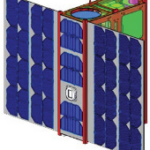
The satellite carries a V/U FM repeater, UHF SSDV and 10G hi-res image downlink.
The telemetry downlink frequency is 435.400 MHz, 9600bd BPSK. A SDR dongle or a rig that supports bandwidth > 12kHz IF output (e.g. IC-705 or IC-9700) is required.
LiveCD for decode can be found at https://tinyurl.com/ANS-308-ASRTU-1.
The preliminary TLE is shown below:
ASRTU-1
1 00000U 24001A 24310.15069444 .00000000 00000-0 00000-0 0 00014
2 00000 097.3998 174.6627 0017604 130.9343 144.0104 15.26720093000011
A special QSL card is planned for first day telemetry reports.
Follow the project at:
https://www.facebook.com/groups/530294498525868/?multi_permalinks=913084726913508&hoisted_section_header_type=recently_seen
[ANS thanks Drew Glasbrenner, KO4MA, AMSAT VP – Operations for the above information.]
Voyager 1 Resorts to Transmitter that Hasn’t Been Used Since 1981
Following recent communication issues, NASA’s Voyager 1 spacecraft resorted to using a backup radio transmitter that has been inactive since 1981.
The interstellar explorer experienced a brief pause in communications after putting itself in a protective state to conserve power. This was triggered by a command sent on Oct. 16 instructing the spacecraft to turn on one of its heaters.
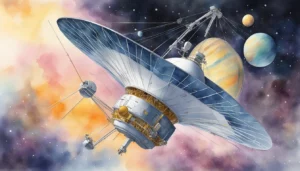
The mission’s flight team first realized there was an issue with Voyager 1 on Oct. 18, when the spacecraft failed to respond to that command. The team later discovered that the spacecraft had turned off its primary X-band radio transmitter and instead switched over to its secondary S-band radio transmitter, which uses less power, according to a statement from NASA. The transmitter shut-off seems to have been prompted by the spacecraft’s fault protection system, which autonomously responds to onboard issues.
The spacecraft’s fault protection system switched to the S-band radio transmitter, which, prior to that date, hadn’t been used since 1981. Given the spacecraft is located much farther away in interstellar space today than it was 43 years ago, the flight team was not sure a signal on the S-band frequency could be detected — especially because it transmits a significantly fainter signal while using less power.
A command was sent to the S-band transmitter on Oct. 22. Two days later, on Oct. 24, the team was finally able to reconnect with Voyager 1.
Voyager 1, which launched in 1977. Its time in deep space has taken a toll on its instruments and caused an increasing number of technical issues. Earlier this year, the team had to fix a separate communications glitch that was causing the spacecraft to transmit gibberish. Read the complete story at https://tinyurl.com/ANS-308-Voyager.
[ANS thanks Space.com for the above information.]
Want to fly the colors on your own grid expedition?
Get your AMSAT car flag and other neat stuff from our Zazzle store!
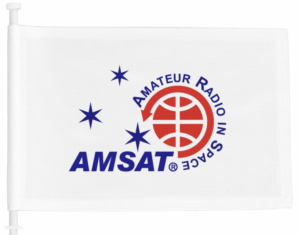
25% of the purchase price of each product goes towards
Keeping Amateur Radio in Space
https://www.zazzle.com/amsat_gear
Changes to AMSAT TLE Distribution for November 1, 2024
Two Line Elements or TLEs, often referred to as Keplerian elements or keps in the amateur community, are the inputs to the SGP4 standard mathematical model of spacecraft orbits used by most amateur tracking programs. Weekly updates are completely adequate for most amateur satellites. TLE bulletin files are updated daily in the first hour of the UTC day. New bulletin files will be posted immediately after reliable elements become available for new amateur satellites. More information may be found at https://www.amsat.org/keplerian-elements-resources/.
The following satellites have been removed from this week’s AMSAT TLE distribution:
UVSQ-SAT NORAD Cat ID 43758 Decayed from orbit on or about 26 October 2024
TianYi 6 NORAD Cat ID 43158 Decayed from orbit on or about 18 October 2024
[ANS thanks Joe Fitzgerald, KM1P, AMSAT Orbital Elements Manager, for the above information.]
ARISS NEWS
Amateurs and others around the world may listen in on contacts between amateurs operating in schools and allowing students to interact with astronauts and cosmonauts aboard the International Space Station. The downlink frequency on which to listen is 145.800 MHz worldwide.

Upcoming Contacts
Instituto Privado Rivadavia, Alderetes, Tucuman, Argentina, direct via LU5KHF.
The ISS callsign is presently scheduled to be NA1SS
The scheduled crewmember is Sunita Williams, KD5PLB.
The ARISS mentor is Brian Jackson, VE6JBJ.
Contact is go for Monday, November 4, 2024 at 13:02 UTC.
Scuola Primaria “Bandello”, Castelnuovo Scrivia, Italy, telebridge via VK6MJ.
The ISS callsign is presently scheduled to be NA1SS.
The scheduled crewmember is Sunita Williams, KD5PLB.
The ARISS mentor is Ferrario Gianpietro, IZ2GOJ.
Contact is go for Thursday, November 7, 2024 at 07:56 UTC.
Completed Contacts
Coastal Community School, Satellite Beach, FL, direct via KD4GPI.
The ISS callsign was NA1SS.
The crewmember ass Sunita Williams, KD5PLB.
The ARISS mentor was Charlie Sufana, AJ9N.
Contact was successful on Wednesday, October 30, 2024 at 13:42 UTC.
Colegio Parroquial el Salvador, Yerba Buena, Argentina, direct via LU5KHF.
The ISS callsignwas NA1SS.
The crewmember was Don Pettit, KD5MDT
The ARISS mentor was Brian Jackson, VE6JBJ.
Contact was successful on Wednesday, October 30, 2024 at 15:32 UTC.
The crossband repeater continues to be active (145.990 MHz up {PL 67} & 437.800 MHz down). If any crewmember is so inclined, all they have to do is pick up the microphone, raise the volume up, and talk on the crossband repeater. So give a listen, you just never know.
The packet system is also active (145.825 MHz up & down).
As always, if there is an EVA, a docking, or an undocking; the ARISS radios are turned off as part of the safety protocol.
Note, all times are approximate. It is recommended that you do your own orbital prediction or start listening about 10 minutes before the listed time.
The latest information on the operation mode can be found at https://www.ariss.org/current-status-of-iss-stations.html
The latest list of frequencies in use can be found at https://www.ariss.org/contact-the-iss.html
[ANS thanks Charlie Sufana, AJ9N, one of the ARISS operation team mentors for the above information.]
Upcoming Satellite Operations
There are no operations listed.
A growing number of satellite rovers are currently engaged in sharing their grid square activations on https://hams.at. By visiting the website, you gain easy access to comprehensive information about the operators responsible for activating specific grid squares. Additionally, you have the ability to assess the match score between yourself and a particular rover for a given pass, while also being able to identify the upcoming satellite passes that are accessible from your location.
[ANS thanks Ian Parsons, K5ZM, AMSAT Rover Page Manager, and Alex Ners, K6VHF, for the above information.]
AMSAT Ambassador Activities
AMSAT Ambassadors provide presentations, demonstrate communicating through amateur satellites, and host information tables at club meetings, hamfests, conventions, maker faires, and other events.
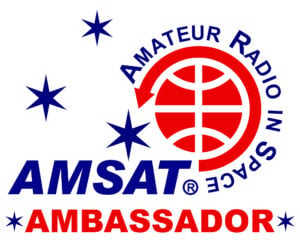
November 9, 2024
Oro Valley Amateur Radio Club
Marana Middle School
11285 West Grier Rd.
Marana, AZ 85653
https://www.tucsonhamradio.org/copy-of-hamfest-2022
N1UW
February 14-15, 2005
Yuma Hamfest & ARRL Southwestern Division Convention
Yuma County Fairgrounds
https://www.yumahamfest.com/
N1UW
Interested in becoming an AMSAT Ambassador? AMSAT Ambassadors provide presentations, demonstrate communicating through amateur satellites, and host information tables at club meetings, hamfests, conventions, maker faires, and other events.
For more information go to: https://www.amsat.org/ambassador/
[ANS thanks Bo Lowrey, W4FCL, Director – AMSAT Ambassador Program for the above information.]
Satellite Shorts From All Over
- As millions of people around the world celebrate Diwali, the Hindu festival of lights, NASA astronaut Sunita Williams radioed home a message of festive cheer. “I want to extend my warmest wishes for a Happy Diwali to everyone celebrating the festival of lights today at the White House and around the world,” Williams said in a recent video message sent from the International Space Station. Speaking from the ISS’ window-filled cupola with Earth as her backdrop, Williams, who is an American with Indian heritage, spoke about her father’s efforts to keep Indian culture alive after he migrated to the United States in 1957. She also touched upon the symbolism of Diwali — the triumph of good over evil, light over darkness and hope over despair. “Diwali is a time of joy as goodness in the world prevails,” she said. [ANS thanks Space.com for the above information.]
- In a few years, as part of the Artemis Program, NASA will begin the creation of permanent infrastructure that will allow for regular missions to the surface (once a year) and a sustained program of lunar exploration and development. In a recent NASA-supported study, a team of researchers at the University of Illinois Urbana-Champaign investigated a new method of sending spacecraft to the Moon. It is known as “multimode propulsion,” a method that integrates a high-thrust chemical mode and a low-thrust electric mode – while using the same propellant. To break it down, a multimode thruster relies on a single chemical monopropellant – like hydrazine or Advanced Spacecraft Energetic Non-Toxic (ASCENT) propellant – to power chemical thrusters and an electrospray thruster (aka. colloid thruster). The latter element relies on a process known as electrospray ionization (ESI), where charged liquid droplets are produced and accelerated by a static electric field. Electrospray thrusters were first used in space aboard the ESA’s LISA Pathfinder mission to demonstrate disturbance reduction. By developing a system that can switch as needed, satellites will be able to perform propulsive manuevers using less propellant, thus requiring fewer fuel transfers. Read the complete story at https://tinyurl.com/ANS-308-Propulsion. [ANS thanks UniverseToday.com for the above information.]
- Has orbital debris gone out of control? In 1978, NASA scientists Donald J. Kessler and Burton G. Cour-Palais proposed a scenario where the density of objects in Low Earth Orbit (LEO) would be high enough that collisions between objects would cause a cascade effect. In short, these collisions would create debris that would result in more collisions, more debris, and so on. This came to be known as the Kessler Syndrome, something astronomers, scientists, and space environmentalists have feared for many decades. In recent years, and with the deployment of more satellites than ever, the warning signs have become undeniable. Currently, there is an estimated 13,000 metric tons (14,330 US tons) of “space junk” in LEO. With the breakup and another satellite in orbit – the Intelsat 33e satellite – the situation will only get worse. Read the full report at https://tinyurl.com/ANS-208-Debris. [ANS thanks UniverseToday.com for the above information.]
Join AMSAT Today at https://launch.amsat.org/
In addition to regular membership, AMSAT offers membership to:
- Societies (a recognized group, clubs or organization).
- Primary and secondary school students are eligible for membership at one-half the standard yearly rate.
- Post-secondary school students enrolled in at least half time status shall be eligible for the student rate for a maximum of 6 post-secondary years in this status.
- Memberships are available for annual and lifetime terms.
Contact info [at] amsat [dot] org for additional membership information.
73 and remember to help Keep Amateur Radio in Space!
This week’s ANS Editor, Frank Karnauskas, N1UW
f.karnauskas [at] amsat [dot] org

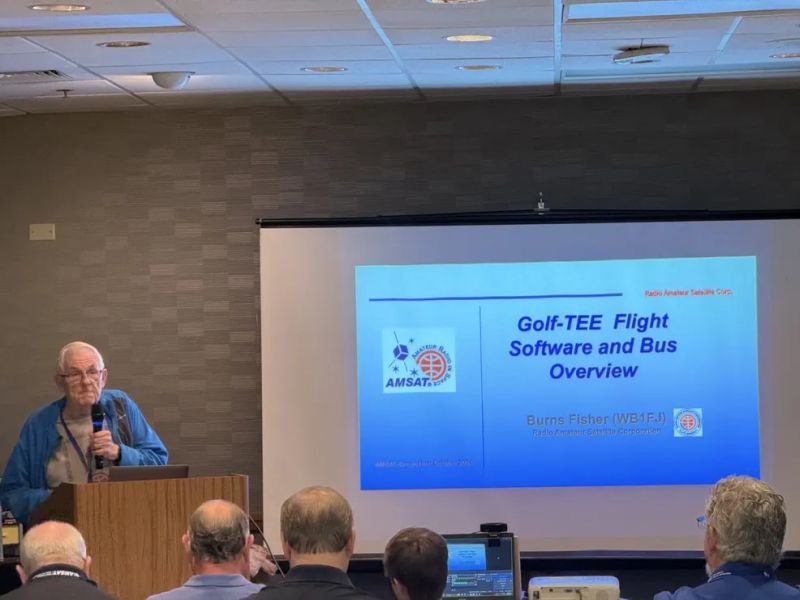
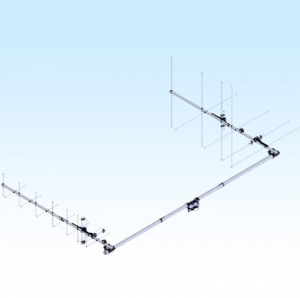
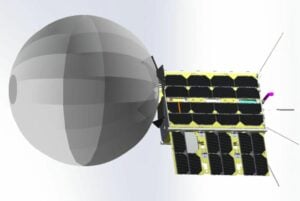
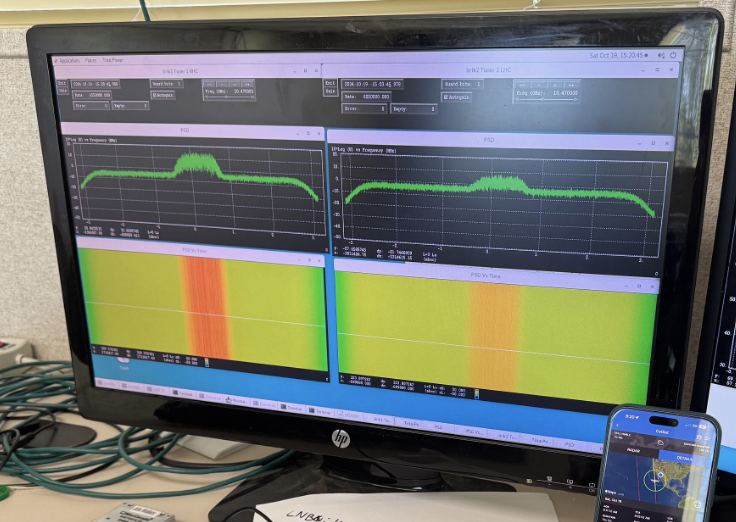
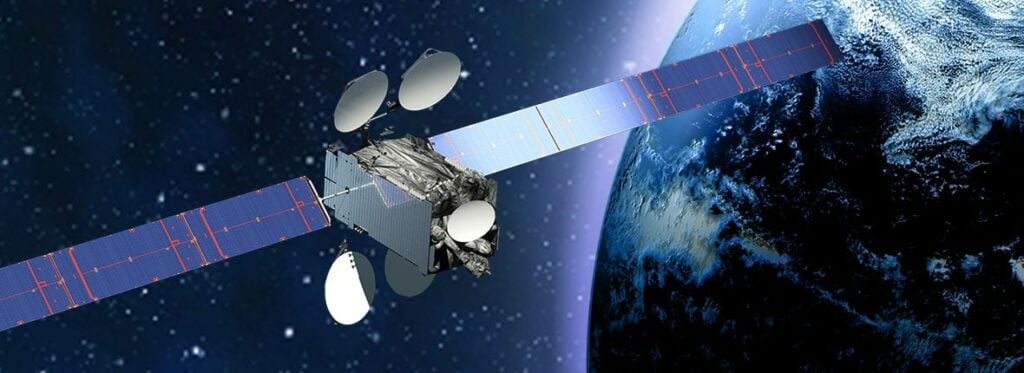

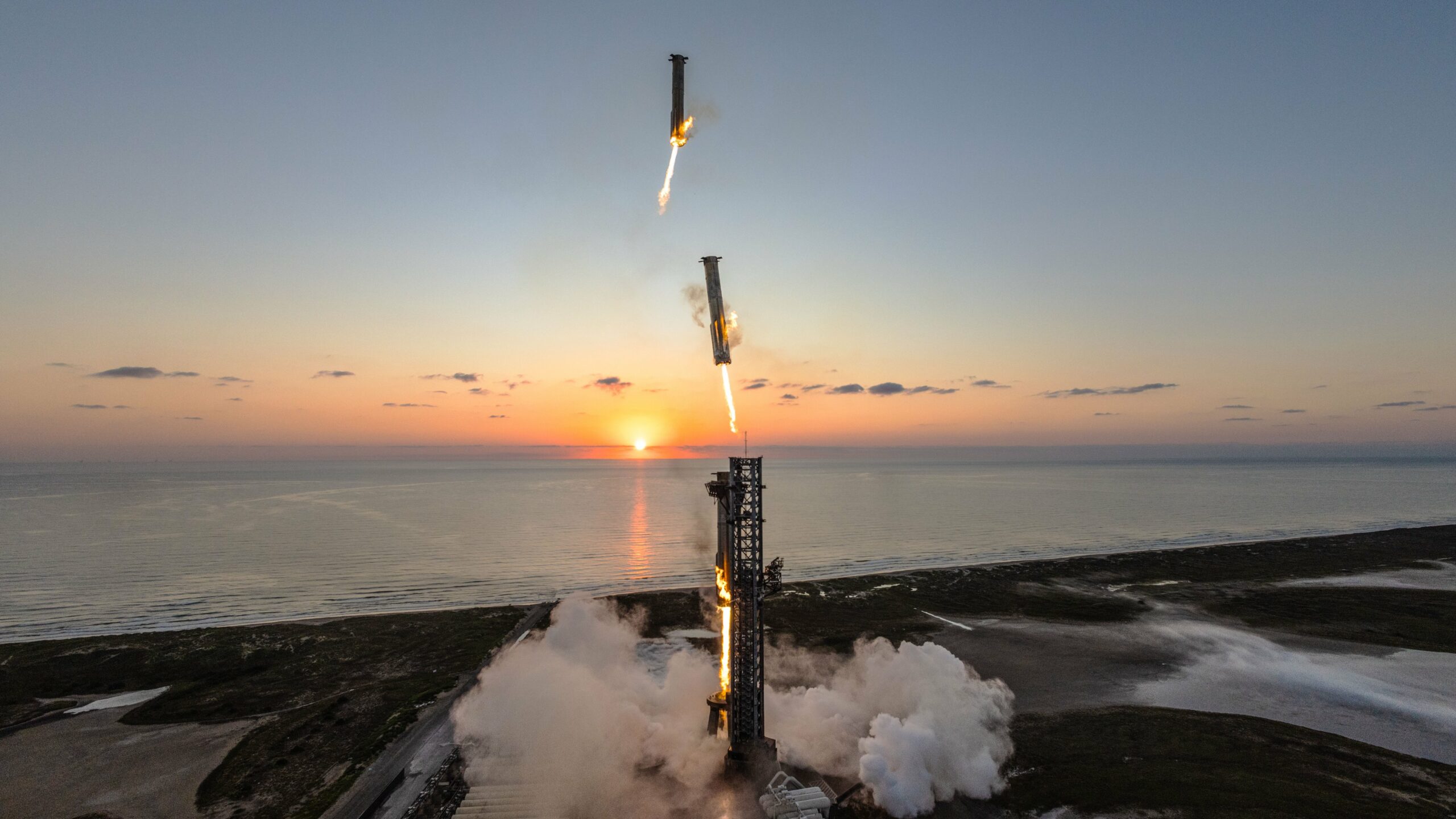
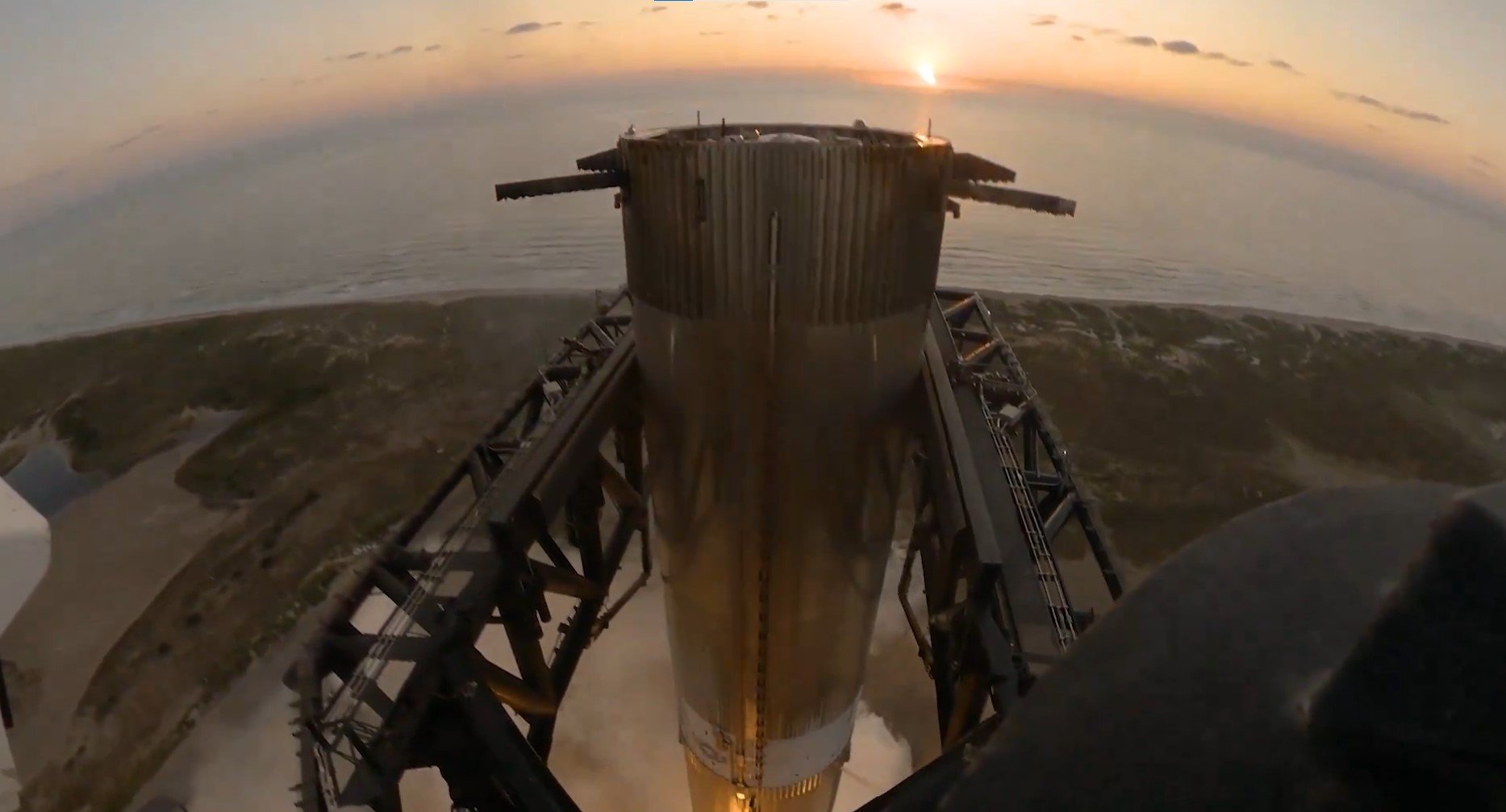
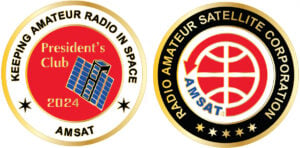 Join the AMSAT President’s Club today and help
Join the AMSAT President’s Club today and help 